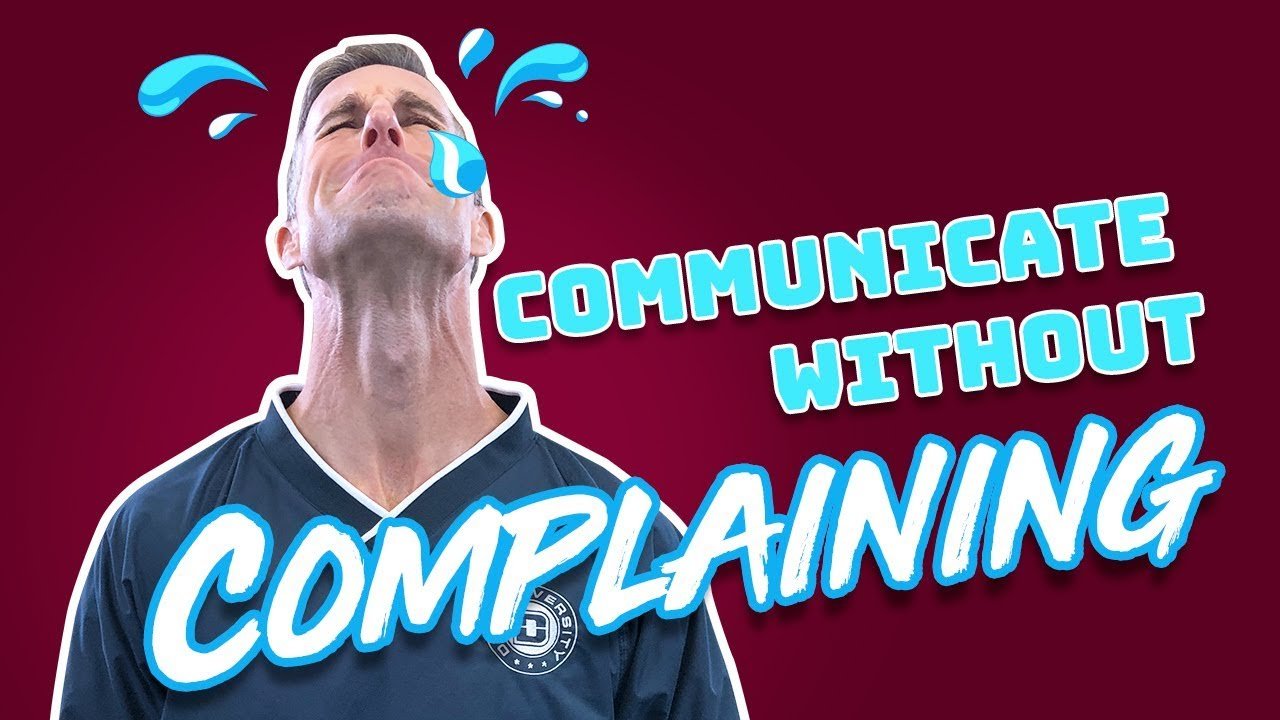In the video titled “Communicating Your Needs Without Complaining,” Jason from Dad University explores the concept of effective communication without resorting to complaining. He shares his experience as a recovering complainer, highlighting how complaining did not lead to getting his needs met. Whether it’s with his wife or kids, Jason emphasizes the importance of communicating one’s needs without complaining. He notes that complaints do not motivate others to change their behavior and discusses the idea of approaching communication as a team effort. By adopting a different approach, such as being vulnerable or sincere, one can make a positive impact and encourage others to want to help. The video offers useful insights and strategies for effective communication without relying on complaints. So, let’s learn how to effectively communicate our needs without resorting to complaining!
Importance of effective communication
Effective communication is an essential component of any successful relationship, whether it be with your spouse, children, friends, or colleagues. It is the key to understanding each other’s needs, resolving conflicts, and building strong connections. However, many people fall into the trap of complaining as their primary mode of communication, which often leads to negative outcomes and strained relationships.
Why complaining is ineffective
Complaining is an ineffective way of communicating because it rarely produces the desired result. When you complain, you are expressing discontent or dissatisfaction without offering a solution or seeking common ground. It often comes across as nagging, whining, or a means of venting frustration. Instead of motivating others to change their behavior, complaining tends to create defensiveness and resentment, making it difficult to find a resolution.
The power of effective communication
On the other hand, effective communication involves expressing your needs, concerns, and desires without resorting to complaining. It focuses on creating a safe and open environment for honest dialogue. When you communicate effectively, you are more likely to be heard and understood, fostering empathy and collaboration. Effective communication allows for deeper connections, builds trust, and strengthens relationships.
Understanding the concept of teamwork
Viewing relationships as a team can significantly impact how you communicate with others. When you approach your relationships with the mindset of being part of a team, you prioritize cooperation, understanding, and mutual support. Just like in a sports team or the military, a 50/50 partnership involves lifting each other up and working together toward a common goal.
The importance of 50/50 partnership
A 50/50 partnership implies an equal distribution of responsibilities and a shared commitment to each other’s well-being. In a relationship, this means acknowledging that both individuals have their strengths, weaknesses, and limitations. Instead of keeping score or placing blame, it’s important to approach challenges as a team, finding ways to support each other and fill in the gaps.
Supporting each other emotionally
In addition to sharing responsibilities, supporting each other emotionally is a crucial aspect of effective communication within a partnership. There may be times when one person is struggling while the other is thriving. During these times, it’s essential to provide emotional support by empathizing, listening, and offering assistance. By showing up for each other emotionally, you strengthen your bond and create a safe space for vulnerability.
The negative impact of complaining
Complaining can have a detrimental effect on relationships, causing distance, resentment, and strain. When you constantly complain, you create a negative atmosphere that can erode trust and happiness. This negativity can permeate all aspects of the relationship, leading to decreased satisfaction and a breakdown in communication.
How complaining affects relationships
Complaining can create a cycle of negativity within relationships. When one party complains, the other person may feel attacked or criticized, leading to defensiveness or counter-complaining. This back-and-forth of complaints can escalate tensions, making it difficult to address the underlying issues effectively. Furthermore, complaining can overshadow positive aspects of the relationship and hinder overall growth and development.
Complaining’s effect on children’s behavior
Children are particularly susceptible to the negative impact of complaining. When parents or caregivers constantly complain, children may internalize this behavior and believe that complaining is an acceptable way to communicate their needs. This can lead to a cycle of negativity, where both parents and children resort to complaining to express their frustrations. Over time, this can hinder a child’s emotional development and create a strained parent-child relationship.

Changing the narrative
Recognizing the inefficiency of complaining is the first step toward changing your communication style. By acknowledging that complaining doesn’t yield the desired results, you can begin to explore alternative approaches to addressing your needs and concerns.
The need for a different approach
Instead of relying on complaining, it’s important to seek alternative approaches to effectively communicate your needs. This shift in approach involves a change in mindset and a commitment to fostering open, honest, and constructive conversations. By embracing new strategies, you can create a more positive and productive dynamic in your relationships.
Effective ways to communicate your needs
When it comes to effectively communicating your needs, there are several strategies that can help you convey your message in a sincere and clear manner.
Being sincere and vulnerable
Sincerity and vulnerability are essential components of effective communication. By authentically expressing your thoughts and emotions, you create a safe space for the other person to understand your perspective. Being open and honest about your needs fosters trust and encourages reciprocity.
Choosing the right tone
The tone in which you communicate can significantly impact how your message is received. It’s important to choose a respectful and non-confrontational tone when expressing your needs. Avoid using accusatory or judgmental language that may put the other person on the defensive. Instead, focus on using compassionate and understanding language to encourage empathy and collaboration.
Expressing your needs clearly
Clarity is key when communicating your needs. Clearly articulate what you need or desire, ensuring that your message is specific and actionable. Vague or ambiguous statements can lead to misunderstandings and frustration. By providing clear instructions or requests, you increase the likelihood of a positive outcome.
Creating open and honest conversations
Open and honest conversations are the foundation of effective communication. Encourage open dialogue by actively listening to the other person’s perspective and validating their feelings. Create a safe and non-judgmental environment where both parties feel comfortable expressing their thoughts and emotions. This fosters understanding and paves the way for finding common ground.
The power of addressing difficulties together
Addressing difficulties together is a vital aspect of effective communication. By viewing challenges as shared responsibilities, you can invite input from the other person and collaborate to find solutions.
Inviting input from the other person
Inviting input from the other person shows respect and acknowledges their perspective. When faced with difficulties, actively ask for their thoughts, opinions, and potential solutions. By involving them in the decision-making process, you create a sense of ownership and shared responsibility.
Collaborating to find solutions
Collaboration is key when it comes to finding solutions. Instead of approaching challenges as individual problems, collaborate with the other person to brainstorm ideas and explore mutually beneficial solutions. By working together, you increase the likelihood of finding a resolution that satisfies both parties.
Avoiding nagging, whining, and complaining
To foster effective communication, it’s crucial to avoid falling into the trap of nagging, whining, or complaining. These negative behaviors can hinder your ability to convey your needs successfully.
Understanding the negative impact of nagging
Nagging is repetitive and negative behavior that often occurs when someone feels their needs are not being met. However, nagging rarely leads to positive results. Instead, it can create resentment and make the other person less likely to respond positively to your requests.
Finding alternative ways to convey your needs
Instead of resorting to nagging, whining, or complaining, find alternative ways to communicate your needs. As discussed earlier, sincerity, vulnerability, and clarity are key components of effective communication. By focusing on these aspects, you can express your needs without resorting to negative behaviors.
Using positive reinforcement and incentives
Motivating others to fulfill your needs can be achieved through the use of positive reinforcement and incentives. Instead of complaining when your needs are not met, use these strategies to encourage the desired behavior.
Motivating others to fulfill your needs through positive reinforcement
Positive reinforcement involves acknowledging and rewarding desired behaviors. When the other person meets your needs, express gratitude and appreciation. This positive feedback reinforces their behavior and increases the likelihood of future cooperation.
The effectiveness of using incentives
Incentives can also be a powerful tool for motivating others. Consider offering rewards or incentives to encourage the other person to fulfill your needs. This can be as simple as expressing your gratitude, treating them to something special, or finding a mutually beneficial compromise.
The role of patience and understanding
Effective communication requires patience and understanding, as change takes time and relationships evolve over time. Recognizing the other person’s perspective can help foster empathy and create a more conducive environment for open communication.
Recognizing that change takes time
Change is a gradual process that requires patience and understanding. It’s important to recognize that people may not immediately meet your needs or adjust their behavior. Instead of becoming frustrated or resorting to complaining, allow time for growth and be supportive as the other person navigates their own journey.
Understanding the other person’s perspective
Understanding the other person’s perspective is crucial to effective communication. Put yourself in their shoes and try to see things from their point of view. By fostering empathy and seeking to understand their needs and concerns, you can create a more compassionate and collaborative atmosphere.
Conclusion
Embracing effective communication as a tool for building stronger relationships is essential for personal and interpersonal growth. Moving away from complaining and toward positive dialogue allows for empathy, trust, and understanding to flourish. By recognizing the importance of teamwork, avoiding negative behaviors, and utilizing strategies such as sincere communication, active listening, and collaboration, you can create stronger, more fulfilling connections with your loved ones.

